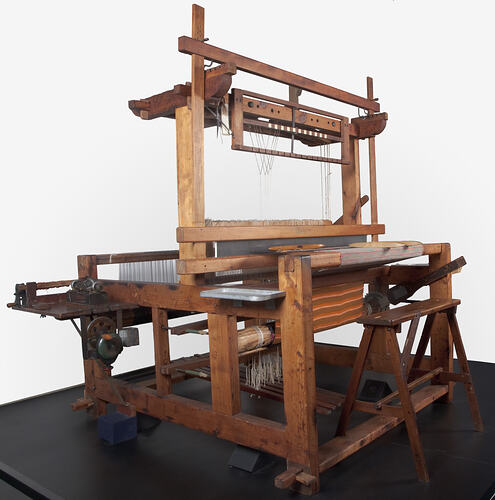Summary
The Apinis weaving collection contains over 150 objects made and used by Latvian migrants, Anna, Ervin and Anita Apinis, in the maintenance of traditional skills and cultural heritage associated with the artistic practice of weaving. It includes brought objects, examples of weaving, photographs and audio visual oral histories. It has been acquired by Museum Victoria in stages since the relationship with the family was first established as part of the immigration and artistic practice project in 1992.
This remarkable collection dates back to 1930, when Anna Apinis commenced studying weaving in Leipaja, Latvia. She spent hours at the Leipaja Ethnographic Museum studying and copying traditional patterns into two notebooks which are now held in the Museum's collection. Anna continued collecting designs during her years in Memmingen, a Displaced Persons camp in Germany, following World War II. The notebooks provide an invaluable record of Latvian weaving patterns and techniques. They also showcase the extent of displacement across Latvia, containing designs from many different regions and providing an insight into some of the items Latvian refugees took with them during their flight from Latvia.
During her time at Memmingen, Anna was asked to weave a traditional Zemgale district wedding costume; however there were no looms in the camp which were large enough to weave the complex costume. Anna's husband, Ervins, designed a multi-draw shaft loom and the bride's fiancé constructed it with the help of fellow refugees using wood scavenged from bombed-out ruins around the camp. This loom is held in Museum Victoria's collection, along with the packing crate in which it was transported.
In 1950 Anna and Ervins migrated to Australia, with their son Erik and Anna's father, Ernest, bringing the loom with them. Anna found it difficult to find suitable weaving materials in post-war Australia, so Ervins designed and built an unplying machine, using cans, scrap metal and wood. He then used the machine to unply balls of wool to make weaving threads for Anna. This machine is also part of the Museum's collection. Anna became one of the few suppliers of fabric for Latvian national costumes in Australia in the 1950s and 1960s, and exhibited her weaving nationally, at exhibitions and Latvian cultural festivals. Museum Victoria's collection contains several examples of this traditional weaving created by Anna, which highlight the importance of cultural maintenance by the Latvian community in Australia during this period.
Anna kept her cultural traditions alive through her daughter, Anita, who she taught to weave. Anita incorporates both modern and traditional elements in her weaving, using traditional symbols primarily for aesthetic reasons, although she is aware of their meanings and origins. The pieces created by Anita in Museum Victoria's collection are illustrative of the creation of 'meaning-general' crafts. These are often used by expatriate communities as a means of maintaining parts of their cultural heritage and traditional skills, although the objects created often becoming separated from their traditional meanings and uses, coming instead to signify a broader cultural or ethnic identity.
The weaving tools and equipment, weavings, notebooks, photographs, and audio and film interviews with Anna and Ervins all contribute to documenting the artistic practices of these remarkable women, as well as the migration experiences of the Apinis family, the role of men in craft practices, and the history of the post-war expatriate Latvian community in Australia.
More Information
-
Keywords
Art, Artists, Crafts, Cultural Identity, Cultural Traditions, Displaced Persons, Immigration, Latvian Communities, Latvian Immigration, National Costumes, Post War Migration, Textiles, Traditional Costumes, Weaving, World War II, 1939-1945
-
Localities
Victoria, Australia, Latvia, New South Wales, Australia, Germany
-
Authors
-
Article types

